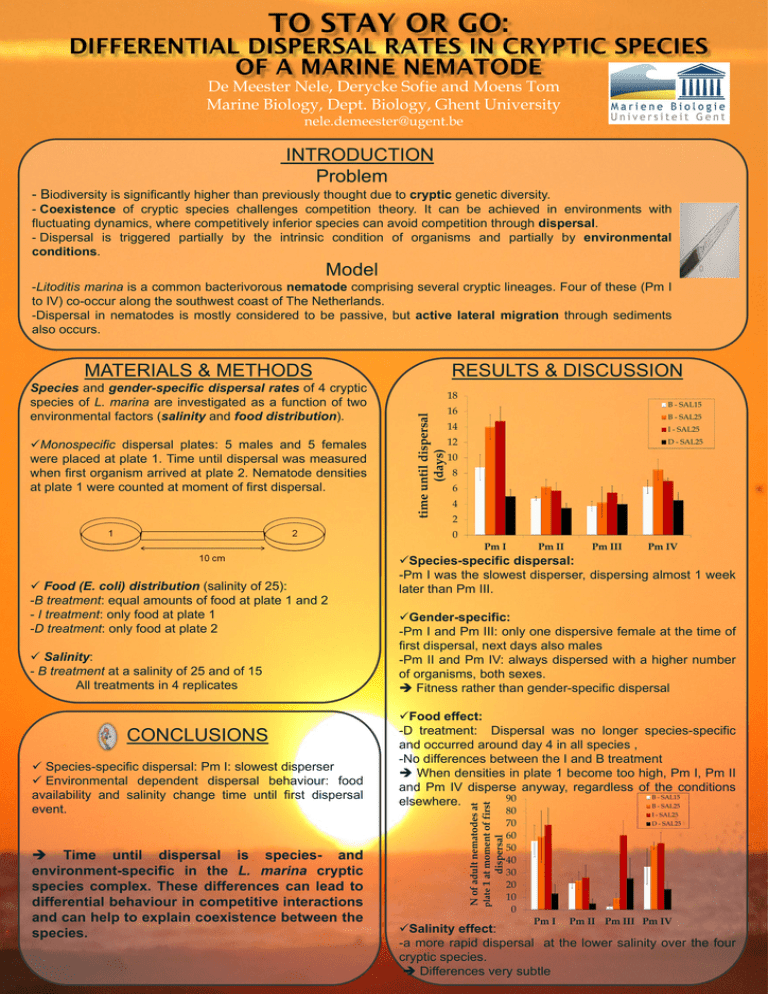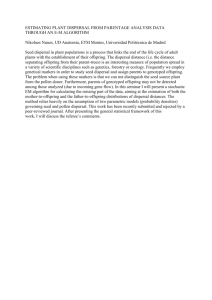INTRODUCTION Problem MATERIALS & METHODS RESULTS & DISCUSSION
advertisement

De Meester Nele, Derycke Sofie and Moens Tom Marine Biology, Dept. Biology, Ghent University nele.demeester@ugent.be INTRODUCTION Problem - Biodiversity is significantly higher than previously thought due to cryptic genetic diversity. - Coexistence of cryptic species challenges competition theory. It can be achieved in environments with fluctuating dynamics, where competitively inferior species can avoid competition through dispersal. - Dispersal is triggered partially by the intrinsic condition of organisms and partially by environmental conditions. Model -Litoditis marina is a common bacterivorous nematode comprising several cryptic lineages. Four of these (Pm I to IV) co-occur along the southwest coast of The Netherlands. -Dispersal in nematodes is mostly considered to be passive, but active lateral migration through sediments also occurs. MATERIALS & METHODS Monospecific dispersal plates: 5 males and 5 females were placed at plate 1. Time until dispersal was measured when first organism arrived at plate 2. Nematode densities at plate 1 were counted at moment of first dispersal. 18 time until dispersal (days) Species and gender-specific dispersal rates of 4 cryptic species of L. marina are investigated as a function of two environmental factors (salinity and food distribution). RESULTS & DISCUSSION B - SAL15 16 B - SAL25 14 I - SAL25 12 D - SAL25 10 8 6 4 2 0 Pm I Salinity: - B treatment at a salinity of 25 and of 15 All treatments in 4 replicates CONCLUSIONS Species-specific dispersal: Pm I: slowest disperser Environmental dependent dispersal behaviour: food availability and salinity change time until first dispersal event. Time until dispersal is species- and environment-specific in the L. marina cryptic species complex. These differences can lead to differential behaviour in competitive interactions and can help to explain coexistence between the species. Pm III Pm IV Species-specific dispersal: -Pm I was the slowest disperser, dispersing almost 1 week later than Pm III. Gender-specific: -Pm I and Pm III: only one dispersive female at the time of first dispersal, next days also males -Pm II and Pm IV: always dispersed with a higher number of organisms, both sexes. Fitness rather than gender-specific dispersal Food effect: -D treatment: Dispersal was no longer species-specific and occurred around day 4 in all species , -No differences between the I and B treatment When densities in plate 1 become too high, Pm I, Pm II and Pm IV disperse anyway, regardless of the conditions B - SAL15 90 elsewhere. B - SAL25 N of adult nematodes at plate 1 at moment of first dispersal Food (E. coli) distribution (salinity of 25): -B treatment: equal amounts of food at plate 1 and 2 - I treatment: only food at plate 1 -D treatment: only food at plate 2 Pm II 80 70 60 50 40 30 20 10 0 I - SAL25 D - SAL25 Pm I Pm II Pm III Pm IV Salinity effect: -a more rapid dispersal at the lower salinity over the four cryptic species. Differences very subtle







